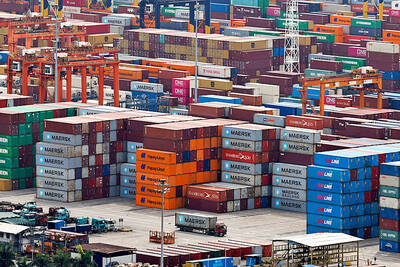The Taipei City Government has approved the resumption of construction on Taipei 101 -- formerly known as the Taipei Financial Center -- over three months after a powerful earthquake detached two tower cranes from their mounts, causing them to hurtle to the ground killing five people.
The Bureau of Labor Affairs and the Public Works Department of the city government issued the notice, permitting full resumption of construction on all floors on June 28 and July 3, respectively.

PHOTO: TAIPEI 101
Permission to resume building on floors from B5 to 23 was granted on May 15, although building restrictions have reportedly cost the company NT$800 million, which are expenses related to workers' wages, insurance premiums and other costs associated with keeping the project going. The figure does not include the cost of reparing the damage caused by the quake.
Construction was halted on March 31 when the earthquake, measuring 6.8 on the Richter scale, sent the two cranes perched on the 56th floor plummeting to earth.
According to Terry Shen (沈雲飛), vice president of the tower's builder -- the Taipei Financial Center Corp (台北金融大樓公司) -- two new cranes are being built in a joint venture between Japan's Nippon Steel and Taiwan's China Steel Corp (中鋼).
The new cranes, which will replace toppled cranes No. 2 and No. 4, will have specially reinforced masts that will be able to withstand strong quakes like the one on March 31, Shen said.
Shen said that the new cranes will have special pin-strengthened masts which are the same as those used in cranes in No. 1 and No. 3 -- which stayed in position during the earthquake.
"The pin-system is much stronger, as was seen during the quake when the other cranes didn't fall," Shen said.
The differences between the four cranes don't stop there. Cranes No. 1 and No. 3 were virtually custom-made for use on the project, while cranes No. 2 and No. 4 had already been used previously in Hong Kong, Shen said.
"The parts and elements are expected to arrive in mid-August and installation will begin in September. There will therefore be no significant progress on the steel structure above the 56th floor until September," according to a company statement.
The city government is currently examining reports submitted by Taipei Financial's main contractor, KTRT, on what caused the crane masts to fail during the temblor. KTRT is formed by Kumagai Gumi, Taiwan Kumagai, RSEA Engineering Corporation (
The report also includes a study of the accident and the safety of the building structure by the Taipei Structural Engineers Association and of tower crane enhancement, conducted by National Taiwan University's Center of Earthquake Engineering Research (CEER).
No decision has been made on whether professional misconduct or criminal negligence were factors in the tragedy.
Taipei 101 is scheduled for completion by 2004.
The biggest single shareholder in what is to be world's tallest building is China United Trust & Investment Corp (中聯信託) -- which has a 20 percent stake. The next leading shareholder is the China Development Industrial Bank (中華開發銀行). The most important anchor tenant of the facility will be the Taiwan Stock Exchange (證交所), which will occupy about seven floors in the building, or about 6,000 pings.

The Eurovision Song Contest has seen a surge in punter interest at the bookmakers, becoming a major betting event, experts said ahead of last night’s giant glamfest in Basel. “Eurovision has quietly become one of the biggest betting events of the year,” said Tomi Huttunen, senior manager of the Online Computer Finland (OCS) betting and casino platform. Betting sites have long been used to gauge which way voters might be leaning ahead of the world’s biggest televised live music event. However, bookmakers highlight a huge increase in engagement in recent years — and this year in particular. “We’ve already passed 2023’s total activity and

Nvidia Corp CEO Jensen Huang (黃仁勳) today announced that his company has selected "Beitou Shilin" in Taipei for its new Taiwan office, called Nvidia Constellation, putting an end to months of speculation. Industry sources have said that the tech giant has been eyeing the Beitou Shilin Science Park as the site of its new overseas headquarters, and speculated that the new headquarters would be built on two plots of land designated as "T17" and "T18," which span 3.89 hectares in the park. "I think it's time for us to reveal one of the largest products we've ever built," Huang said near the

China yesterday announced anti-dumping duties as high as 74.9 percent on imports of polyoxymethylene (POM) copolymers, a type of engineering plastic, from Taiwan, the US, the EU and Japan. The Chinese Ministry of Commerce’s findings conclude a probe launched in May last year, shortly after the US sharply increased tariffs on Chinese electric vehicles, computer chips and other imports. POM copolymers can partially replace metals such as copper and zinc, and have various applications, including in auto parts, electronics and medical equipment, the Chinese ministry has said. In January, it said initial investigations had determined that dumping was taking place, and implemented preliminary

Intel Corp yesterday reinforced its determination to strengthen its partnerships with Taiwan’s ecosystem partners including original-electronic-manufacturing (OEM) companies such as Hon Hai Precision Industry Co (鴻海精密) and chipmaker United Microelectronics Corp (UMC, 聯電). “Tonight marks a new beginning. We renew our new partnership with Taiwan ecosystem,” Intel new chief executive officer Tan Lip-bu (陳立武) said at a dinner with representatives from the company’s local partners, celebrating the 40th anniversary of the US chip giant’s presence in Taiwan. Tan took the reins at Intel six weeks ago aiming to reform the chipmaker and revive its past glory. This is the first time Tan